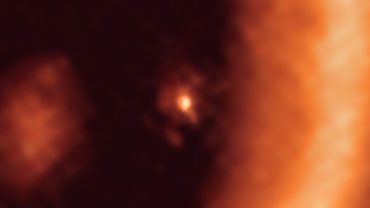
A close-up view on the moon-forming disc surrounding PDS 70c. Image credit: ALMA (ESO/NAOJ/NRAO)/Benisty et al.
The last month or so has seen several cases of small things being discovered. The first is an asteroid, 2021 27PH, which gets closer to the Sun than Mercury. What could we learn about fundamental science from such an object?
The second is one of the smallest exoplanets detected, at less than half the mass of Venus. It orbits very close to its star, and would have very high temperatures on its surface, so it’s not a place to look for life (at least not as we know it). But finding planets so small, even around a relatively close star, shows just how sensitive these detection methods are getting.
But the focus of this month is not planets or asteroids, but moons. Specifically, the formation of “exomoons” – moons orbiting planets around another star. Detected using the ALMA telescope array, this is the first time we’ve seen this happening, and has intriguing implications for our understanding of the formation of our own Solar System. Dr Stefano Facchini, from University of Milan, explains how this discovery was made, and what we’re learning from it.





